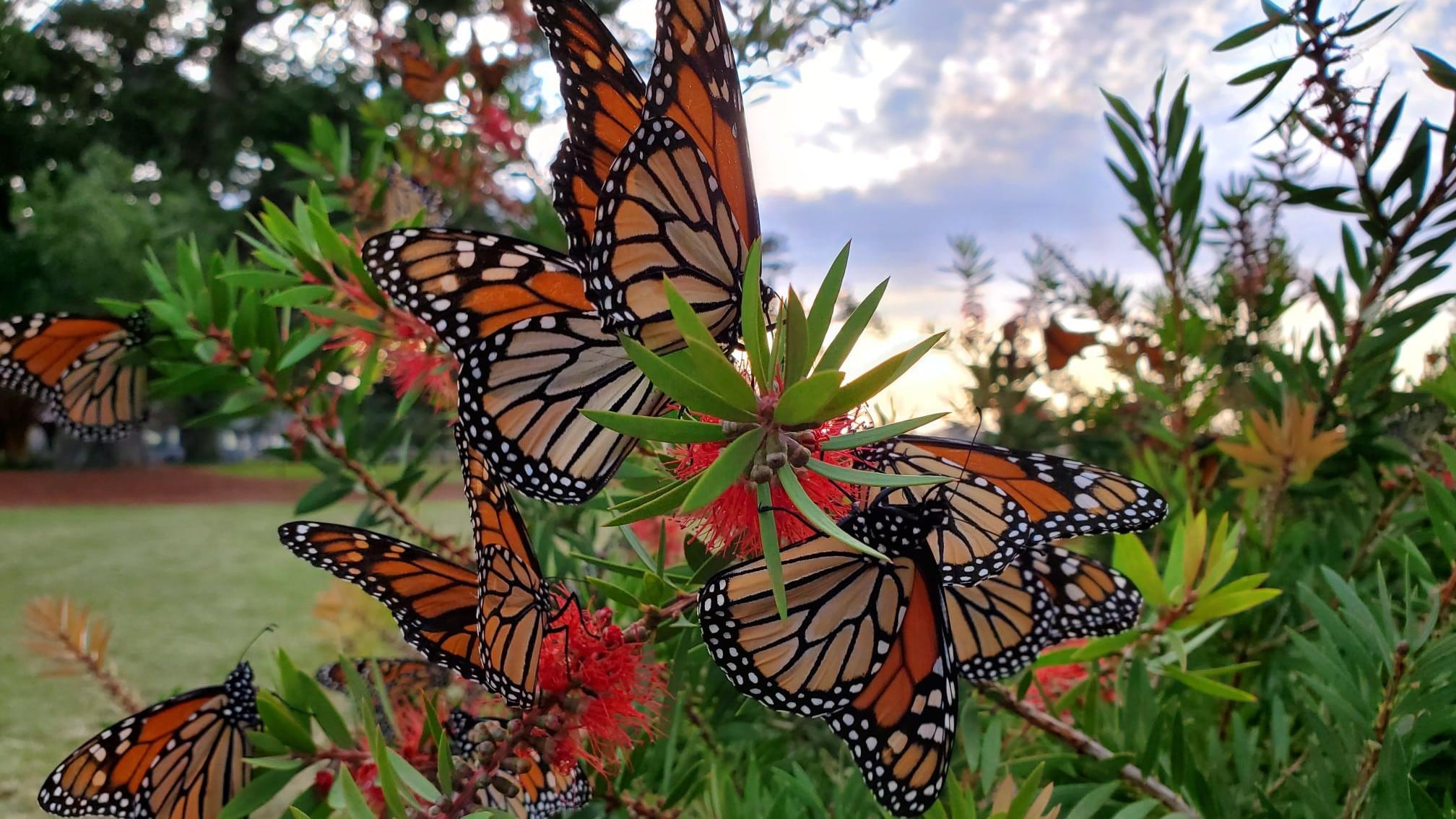You will have the opportunity to witness some of these amazing insects along the Alabama coast this fall when millions of monarch butterflies travel from Canada to Mexico.
In Baldwin County, a number of organizations—including hotels, utilities, and gardeners—are now giving the endangered butterflies the milkweed habitat they need.
Lee Weston, house grounds manager of the Grand Hotel in Point Clear, which has a pollinator garden, stated, “Maybe you can’t save the world, but maybe you can save this part of it.”
In south Baldwin County, it is currently one of five monarch butterfly waystation habitats. With thousands of new residents, hundreds of new houses, and developments every year, Baldwin is one of the fastest-growing counties in Alabama and one of the fastest-growing metropolitan areas in the country.
The only Monarch City in the state is also located there.
The first Monarch City in Alabama, Foley, was named in June by Monarch City USA, an environmental organization devoted to protecting butterflies.
Additionally, Riviera Utilities installed a new pollinator garden for the beautiful orange and black butterflies in the city this month.It is an additional habitat designed to supply milkweed for the migratory butterflies to lay their eggs and nectar for them.
After decades of population loss, the U.S. Fish and Wildlife Service proposed in December to classify the monarch as threatened under the Endangered Species Act. The National Wildlife Foundation reports that although the eastern monarch butterfly population, which includes those that stop in Alabama, grew between 2023 and 2024, it has still decreased by 80% during the previous three decades.
The loss of their host plant, the milkweed, is one factor contributing to their decrease. Since monarch butterflies can only lay their eggs on milkweed, it is essential to their survival. Also, only milkweed is consumed by monarch caterpillars.
Weston, who helped establish the pollinator garden at the Grand Hotel, said, “I feel good just to help one thing that’s struggling, and knowing that the entire community is getting involved gives me hope that we may be able to make a massive difference at some point.”
Additionally, the work to establish habitat for monarchs in south Baldwin County started several years ago, even though Foley was only named a Monarch City this summer.
Milkweed vs. Milkweed
Dozens of people gathered in a small garden at the corner of Riviera Utilities offices in Foley on a steamy Wednesday morning in July. Children anxiously gazed at a little monarch butterfly caterpillar crawling on the underside of a leaf as volunteers from Foley’s public library read stories to them and distributed seed packets.
The garden includes yarrows, cigar plants, and—above all—three varieties of native milkweed.
According to Josh Roberts, vegetation management superintendent at Riviera Utilities, the native population of pollinator plants and milkweeds is decreasing as a result of land use changes and land development. Milkweed is the main plant used by monarchs. Therefore, the monarchs’ migration from Canada to Mexico depends on the presence of native milkweed.
Beginning in 2020, Roberts proposed a pollinator garden. In 2023, Riviera Utilities consented and set aside an area for milkweed and other natural plants so that butterflies might rest and feed. In order to examine their monarch butterfly initiatives, he got in touch with Weston.
Knowing that monarchs would visit the Grand Hotel grounds, Weston and the grounds team have long worked to establish flowers and plants that produce a lot of nectar for the butterflies to consume. Weston says that 7,000–8,000 monarch butterflies visited the hotel a few years ago during their migration and remained for over a month.
She met Roberts, who was attempting to launch Riviera’s pollinator garden, after the Grand’s had been operating for a few years.
Carmen Flammini, a scientist from Auburn University’s Cooperative Extension System, became their collaborator. Flammini, an agricultural engineer, developed an interest in monarch butterflies while establishing a garden at her kids’ school in Georgia.
However, Flammini swiftly undid their work by informing them that they had planted tropical milkweed, which was a mistake. The monarch butterflies will continue to consume the tropical milkweed and never migrate to their wintering habitat if they come across it too early in their migration path. According to the University of Florida, it may also interfere with the caterpillar stage of the butterfly’s life.
Both Weston at the Grand Hotel and Roberts at the Riviera featured tropical milkweed in their gardens. They removed it and planted native varieties of milkweed in its place. “Graham Creek Nature Preservein Foley planted native milkweed in one of its pitcher plant bogs at Flammini’s direction, and recently in a deer-protected area of the preserve,” said Leslie Gahagan, the preserve’s director of sustainability and natural resources.
It’s paying off. According to Gahagan, butterflies are already drawn to the native milkweed species in the preserve. It is hoped that an increasing number of butterflies would pause at these waystations as the monarch migration commences next month and continues throughout the fall.
Five waystation habitats in the county are currently under Flammini’s advice. Monarch butterfly habitats can also be found at the Gulf Coast Eco Center in Gulf Shores and Pelican’s Nest Science Lab in Fairhope.
The extension manages the Baldwin County Master Gardeners group, which helps all of the waystation habitats with garden maintenance and bug research.
More than butterflies
The native plants are used by different insects, thus the pollinator gardens benefit more than just monarch butterflies. Currently, Auburn is working with four of the five monarch butterfly habitats to identify Alabama’s bee species.
The goal of the study is to determine which of the 400–500 bee species found in the state consume native milkweed. Volunteers with training as master gardeners visit the gardens a few days a week to collect bees, which are then transported to Auburn for analysis.
Additionally, Flammini wants to learn more about Baldwin County’s native milkweed growth and the interactions between the plants and monarchs and other pollinators during their visit. Master gardeners keep track of how many eggs are laid on each milkweed plant, how many caterpillars hatch, and how many reach adulthood and chrysalis.
According to Flammini, the goal is to establish a standard for growing native milkweed. She intends to extend her research to pollinator gardens across the state in the future.
People have responded enthusiastically to these attempts to save the monarchs. Earlier this month, the Riviera Utilities pollinator garden inauguration festivities drew close to 200 attendees. According to Weston, her family has started growing natural milkweed in their houses.
Graham Creek Nature Preserve is owned by the City of Foley, which is investing considerably more in butterfly protection. The environmental preserve plans to build a butterfly conservatory. There will be a variety of butterfly species in the indoor conservatory, but the main attraction will be monarchs. Monarch butterfly-focused pollinator gardens will be located outside the greenhouse.
According to Gahagan, the goal was to inform all park visitors about the various ways they could employ native landscaping and ideas to draw in more bees and butterflies. The public’s knowledge of how to design their own monarch pollinator-style gardens might be greatly expanded.
It is anticipated that the conservatory will cost approximately $400,000. Most of the funding is coming from the city of Foley. Additionally, the conservatory received $150,000 from the University of South Alabama’s Gulf Coast Environmental Engagement Center.
Flammini said she hopes the communal effort to aid monarch butterflies can be used as a symbol of what can be achieved if people are more mindful.
To me, the monarch is more like a symbol of what you can do if you improve your ecosystem, and also the responsibility that we have when we plant certain plants, Flammini said. So instead of planting something that looks just pretty, why don t we plant something that can help an insect to finish or prolong their life cycle.
Most Popular Stories by
Margaret Kates
-
Get ready to see these tiny, vicious birds at feeders in Alabama this fall
-
Alabama coal ash site may be dirtiest in the nation, environmental group says
-
Catch the cigar with wings flying around chimneys in Alabama this summer
-
Alabama Power coal ash pond leaks harmful metals into Coosa River, new lawsuit alleges






